
Leonardo Loredan was a Venetian nobleman and statesman who reigned as the 75th Doge of Venice from 1501 until his death in 1521. As a wartime ruler, he was one of the most important doges in the history of Venice. In the dramatic events of the early 16th century, Loredan's Machiavellian plots and cunning political manoeuvres against the League of Cambrai, the Ottomans, the Mamluks, the Pope, the Republic of Genoa, the Holy Roman Empire, the French, the Egyptians and the Portuguese saved Venice from downfall.

Haydée, ou Le secret is an opéra comique by the French composer Daniel Auber, first performed by the Théâtre Royal de l'Opéra-Comique at the Salle Favart in Paris on 28 December 1847. The libretto is by Auber's regular collaborator, Eugène Scribe and is based on a short story by Prosper Mérimée, La Partie de trictrac (1830).

The Portrait of Doge Leonardo Loredan is a painting by Italian Renaissance master Giovanni Bellini, dating from c. 1501–02. It portrays Leonardo Loredan, the Doge of Venice from 1501 to 1521, in his ceremonial garments with the corno ducale worn over a linen cap, and is signed IOANNES BELLINVS on a cartellino. It is on display in the National Gallery in London.
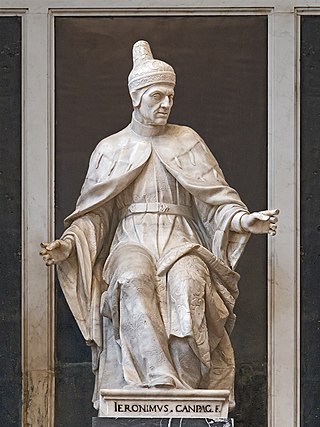
Girolamo Campagna (1549–1625) was a Northern Italian sculptor.

The House of Loredan is a Venetian noble family of supposed ancient Roman origin, which has played a significant role in shaping the history of the entire Mediterranean. A political dynasty, the family has throughout the centuries produced a number of famous personalities: doges, statesmen, magnates, financiers, diplomats, procurators, military commanders, naval captains, church dignitaries, writers, and lawyers.

Ca' Loredan Vendramin Calergi is a 15th-century palace on the Grand Canal in the sestiere (quarter) of Cannaregio in Venice, northern Italy. It was commissioned by the patrician Loredan dynasty, namely Andrea Loredan, and paid for by Doge Leonardo Loredan, with construction starting in 1481. The architecturally distinguished building was the home of many prominent people through history and was the place where composer Richard Wagner died.

Pietro Loredan of the noble Loredan family, was the 84th Doge of Venice, reigning from 1567 to 1570.

Francesco Loredan was a Venetian statesman and magnate who served as the 116th Doge of Venice from 18 March 1752 until his death in 1762. He was a member of the noble House of Loredan, head of its Santo Stefano branch, and the only Doge, as well as the last male, to be awarded the Golden Rose by the Papacy.
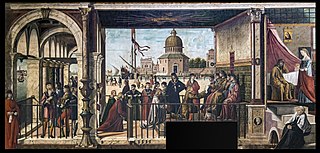
The Legend of Saint Ursula is a series of large wall-paintings on canvas by the Italian Renaissance artist Vittore Carpaccio, commissioned by the Loredan family and originally created for the Scuola di Sant'Orsola (Ursula) in Venice, which was under their patronage. They are now in the Gallerie dell'Accademia in Venice.
This is an alphabetical index of people, places, things, and concepts related to or originating from the Republic of Venice. Feel free to add more, and create missing pages.
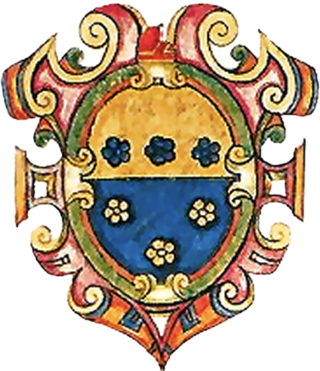
The House of Loredan-Santo Stefano was a cadet branch of the House of Loredan that existed from the 14th century until 1767. The branch was mainly settled in the Palazzo Loredan in Campo Santo Stefano, which they acquired in 1536 from the Mocenigo family. The progenitor of the branch is considered to be Gerolamo Loredan "dal Barbaro" di S. Vitale (d.~1474), father of Doge Leonardo Loredan and Dogaressa Caterina Loredan. Besides Leonardo, the branch also gave Doge Francesco Loredan.
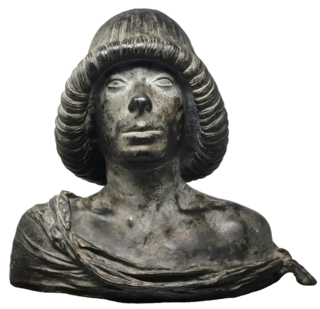
Andrea Loredan (1440–1513) was a Venetian nobleman of the Loredan family, known as a collector of art. He is notable for commissioning the Ca' Loredan Vendramin Calergi, a palace on the Grand Canal, to designs by Mauro Codussi. The palace was paid for by Doge Leonardo Loredan, it is known for its association with Richard Wagner and the palace today hosts the Casino of Venice. Andrea is also notable for paying for the choir of the church of San Michele in Isola, also designed by Codussi.
Caterina Loredan of the noble Loredan family was the Dogaressa of Venice from 1521 to 1523 by marriage to Doge Antonio Grimani.

The Portrait of Doge Pietro Loredan is a painting by the Italian Renaissance master Jacopo Robusti, more commonly known as Tintoretto. It was painted in around 1567–1570, while Pietro Loredan reigned as the Doge of Venice. It is on display at the Kimbell Art Museum in Fort Worth, Texas.
Loredan is a Venetian surname. The House of Loredan is an aristocratic Venetian family that included various doges of the Republic of Venice, and the surname is almost exclusively associated with the family. The surname most likely originated from the toponym Loreo, which itself originated from its Latin name Lauretum, meaning laurel. Another theory of the origin of the surname, though most likely legendary, is that it comes from the Latin epithet Laureati, given to ancestors of the Loredan family due to their historical glory in ancient Rome and the many victories they achieved in battles. The surname is spelled Loredano or Loredan in Italian, Lauredano or Lauredanus in Latin, and Lorentano (Λορεντάνο) in Greek, though it is also historically found as Lordas (Λορδᾶς) and Lordano (Λορδάνο). The feminine name Loredana, common in Italy and Romania, was likely inspired by the surname.
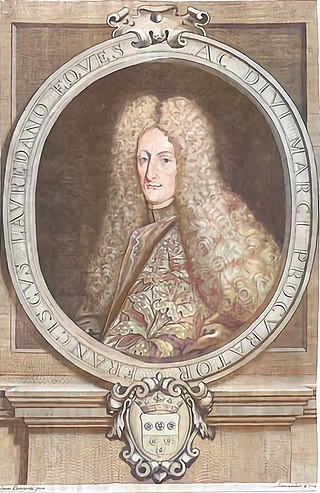
Francesco Loredan was a Venetian magnate and nobleman of the Loredan family, and an ambassador of the Republic of Venice to Vienna during the peace negotiations between the Ottoman Empire and the Holy League, which resulted in the Treaty of Karlowitz (1699).
Andrea Loredan (1455–1499) was a Venetian admiral and the Duke of Corfu, as well as a member of the noble family of Loredan. He is known for his successful exploits against pirates who raged across the Adriatic and the Mediterranean.

The Tomb of Doge Leonardo Loredan is a monumental 16th-century burial site located in the Basilica of Saints John and Paul in Venice, Italy. Interred in it are Leonardo Loredan, 75th Doge of Venice, and his descendant Francesco Loredan, 116th Doge of Venice, both members of the Santo Stefano branch of the House of Loredan.

Doge Leonardo Loredan with Four Sons, also Portrait of the Loredan Family, is a large tempera-on-poplar painting by the Italian Renaissance master Giovanni Bellini depicting the noble Loredan family of Venice, namely Leonardo Loredan, Doge of Venice and his four sons, Lorenzo, Girolamo, Alvise, and Bernardo. It was painted in 1507 and is now on display at the Gemäldegalerie, part of the Berlin State Museums.

The Portrait of the Doge Giovanni Mocenigo is a tempera-on-wood painting attributed to Italian artist Gentile Bellini, datable between 1478 and 1485. It is held at the Museo Correr, in Venice.














